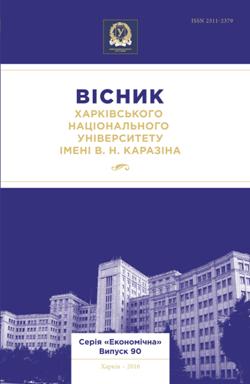RESERVE CURRENCIES IN THE STRUCTURE OF THE WORLD CURRENCY SYSTEM
Abstract
In order to identify the place of reserve currencies in the world currency system, their nature was investigated using the historical approach. The development of the world currency system underwent several stages; each of them took a relatively long historical period. The difference between different world currency systems was that which of them was considered as a reserve one (gold, dollar, other currency, which served as an international means of payment).
The first world currency system was the Paris currency system. It was legally implemented by the international agreement at the Paris conference in 1867 and declared gold the only form of world money. During the existence of the Paris currency system the preconditions for the formation of reserve currencies appeared. The second world currency system was legally implemented by the interstate Genoa international economic conference in 1922. It was based on the gold exchange standard based on gold and main currencies, which were converted into gold. The basic principles of the Bretton Woods currency system were agreed by the leading countries at the international conference in Bretton Woods in 1944. The Bretton Woods system was based on the gold exchange standard, which meant that some currencies in international settlements are treated as gold equivalents, and can function as reserves . Jamaican currency system (1978) operates as a system of managed floating exchange rate. National currencies (the so-called «reserve» currencies) of the world leading countries became the foreign exchange reserves and the main settlement asset. The leading reserve currency is the US dollar, which formally doesn’t correspond to that status.
The basis for functioning of the world currency system as a whole is in the determination of the currency ranges as reserve means and their number.
Downloads
References
2. Заблоцька Г. О. Світові тенденції акумуляції та використання міжнародних золотовалютних резервів / Г. О. Заблоцька // Галицький економічний вісник. – 2010. – № 2 (27). – С. 11–17.
3. Кержковська Д. Р. Проблеми і перспективи розвитку світової валютної системи в умовах глобальної економічної кризи / Д. Р. Кержковська // Механізм регулювання економіки. – 2010. – № 1. – С. 237–244.
4. Dobbs R. An exorbitant priviledge? Implications of reserve currencies for competitiveness: Discussion paper / R. Dobbs, D. Skilling, W. Hu, S. Lund, J. Manyikaand C. Roxburgh. – McKincey Global Institute, 2009. – 49 p.
5. Козюк В. В. Резервний статус валюти в глобальній економіці: проблема темпоральних конфліктів / В. В. Козюк // Вісник Національного банку України. – 2014. – № 4. – С. 30–36.
6. Reform of the International Monetary and Financial System. Trade and Development Report. Chapter IV [Electronic resource]. – 2009. – Way of access: http://unctad.org/en/docs/tdr2009ch4_en.pdf
7. Report of the Commission of Experts of the President of the United Nations General Assembly on Reforms of International Monetary and Financial System [Electronic resource]. – 2009. – Way of access: http://www.un.org/ga/president/63/interactive/financialcrisis/PreliminaryReport210509.pdf
8. Palais-Royal Initiative. Reform of the International Monetary System: A Cooperative Approach for the Twenty First Century. – Paris, 2011. – 23 p.

